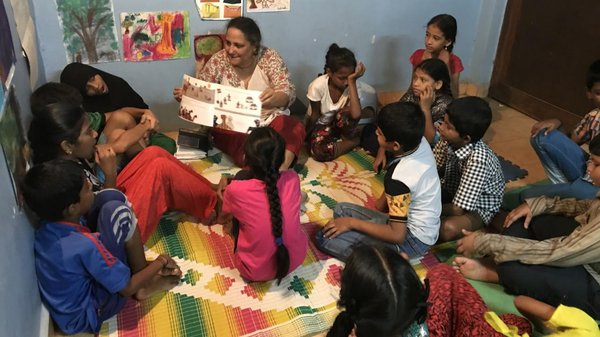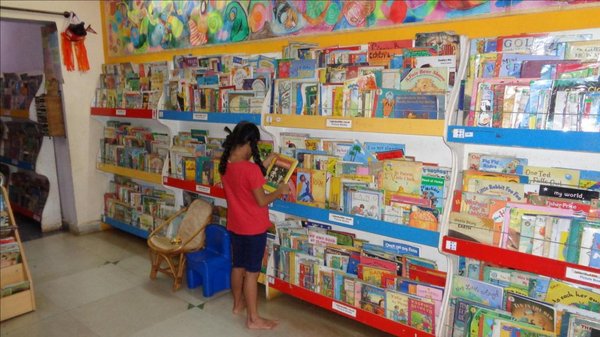
Sujata Noronha,
Bookworm, Goa
Understory talks to Sujata Noronha, who facilitates reading among children, about relationships that stories create.
1. You have nurtured a new community centred around children of different ages and backgrounds in Goa. Could you tell us a little about this journey, and how it has shaped your Library Educator's Programme?
I can only respond to this with hindsight. It was somewhere on the journey of experiencing the deep impact books and conversations had on my thinking and those of the children I worked with, that I began to imagine what would happen if we multiply this process through other adults. The early conception of trying to understand why libraries and children were not vital social spaces led me to see that a wee gap existed in how we imagine adults in the library and the role they perform, and my background in education compelled me to imagine a practitioners course / program that could fill this gap. From there, my mind took over and a rather remarkable course has birthed and gotten richer with every iteration because of the community that come to the course and always the children who enrich our understanding.
I am who I am because I love children, my own, and who I work with and who trust me. Their worlds are important to me. I think I can see some things from a child’s point of view. I would say that having access to stories is a right of every child, and then also, access to books. In retrospect, that may be the reason I began the children’s library. But back then, I did not think so much about it.
2. In your experience, what do you think makes for a good story that remains with the reader long after the book has been put away? Could you talk about some books that have made an impression on children?
This is a rather contentious topic isn’t it? Many people believe quite strongly that there is no such thing as a bad book and they are not incorrect. The same holds for a story, told or read or watched. But what I think is an interesting way to approach this question is what remains after the experience. Perhaps this can be illuminated through something Rebecca Lukens refers to when she claims that literature helps us to struggle with the question of what it is to be a complicated human being living in a complicated world. We cannot be sure which book or which experience, line, thought within which story will trigger a reflective moment for a reader and so we curate, diversify the collection and listen at all times to the rhythm and pulse of where our children are in their life at the time. I would not be able to nominate any list here because it is ever changing, what I can say however is that there is plenty of ‘popular fiction’ that is forgettable and we work hard at resisting those for continuous reading.
All kinds of writing have a place in one’s life. What is for children need not be written by children. Writing is a craft which requires a developmental maturity – even an adultness – in order to be fine writers. The point is to capture something that will relate to whom you are writing for.
I began with books that my children enjoyed. There’s a story about how we ordered our first Tulika book. It came by parcel post, the modem would make those large sounds and took 15 minutes to connect, email was itinerant. I watched India’s publishing houses begin to produce children’s books. We only had NBT and CBT books at the time. There is a small science organization called Bharati Gyan Vijnan Samiti that also offered us black and white versions of some wonderful books when the landscape was stark around 25 years ago. They carried biographies of scientists as well. – black and white brochures. When I attended the Delhi Book Fair in the 70s and 80s, BGVS had rights to certain children’s books that they had translated to Hindi and it was available in a bilingual format. They had a book – a beautiful story- by Munro Leaf called The Story of Ferdinand published in 1935. We have a black and white copy at our home and now multiple copies in the library of this outstanding text. I also discovered Arvind Gupta through my friend Amrita Patwardhan and found a treasure trove of books on his website but our physical collections were always dependent on the ‘market’ and access.
3. You often get into 'reading relationships' with children. As a librarian, can you reflect on this experience of moving the child?
Hmmm, I would add that the child moves me as well in these reading relationship scenarios. So it is genuinely a two way process because I enter into it with that frame and I am always rewarded. What it means for me at this time is that I am deeply curious to understand where the child is on her own reading journey. Not in terms of her skill of reading, but her interests, her motivations, her desires in that moment. I find that talking about these things enables the child to enter into a relationship with me as one who cares and is interested, which I am. From there moving to the stacks, making recommendations over time, following the rhythm of the child’s mood and curbing my own enthusiasm are small steps that have strengthened my approach. When a child moves with you, it is a marker of a particular kind on the journey and often times you can move away onto another child because the core has been activated. Reading and texts do their work thereafter.
When I began the library, there was a programme called Chhota Bheem on television. A young boy came into the library and wanted only Chhota Bheem. I got someone in Bombay to find and send those books to us. We still have two books by a publisher on Chhota Bheem. I called his mother to say we had the books. He is a third-year law student now, and remembers that when he was 5-6 years old, I got him the book he wanted. He moved away from it quickly. I want to say that intention changes practice. My job is to move the child. If I had kept him at Chhota Bheem then I have not been a responsible librarian.
Another time, a parent came to me asking to bring her son out of the Geronimo series which has been holding children in thrall thanks to Scholastic’s marketing. Her son had read eighteen books in this series, and someone had told him that Bookworm may have the titles he hadn’t read. I was excited to meet him, and asked him to tell me some of the stories. I was watching him look at me with wide eyes, while exploring the books on the shelf. I thought he may be feeling tested. He mentioned a mouse and made some general comments. So, I asked him whether the books leave him with something to think about, and I told him I wanted to know because his thoughts were important to me. He took a book that day, and his mother called me later to convey his response – that he did not remember anything much after reading the story! This is the moment for me! I will tell him that there are different kinds of stories, apart from ones like this that give him joy in the moment. I have done this with children before so I know the pattern and how to introduce a story that the child may remember. I can shift his reading in a couple of months but it takes effort, trust and conversations. But my role is to widen and deepen his diet. Some children with whom I’m in reading relationships with will assert their way with me, and that opens my world. So we learn together and given how many books are out there it is important for me to be in touch with the children so that I too learn.
4. What can we learn from children's fiction in terms of telling stories for adults?
I am not able to completely discriminate between the two, because there are so many books for children that deeply strike chords in adults. Honest writing , fantastical imaginations, layered stories that show us more on each reading / revisiting could be some small leads.
5. How do different forms of storytelling attract different kinds of audiences?
We need to have all forms of storytelling on offer and be wild and wanton in that sharing. The one that a particular member of an audience is drawn to will speak to that person in that telling. There is no sure - fire recipe for this, rather the surety is in the text. A good story in any form will compel attraction.
As adults, there are topics we are concerned about and we put them in the way of children. Children aren’t naturally drawn to these books, even if it speaks to their experience. It is hard, developmentally and emotionally, for a child to say that they need something. It is easier for an adult to admit that they are going through a difficult time and need to talk to someone. So, adults in the child’s life need to put the book in the way of the child. These books don’t fly off the shelf even in an open library, but children can be led to them.
Children are in a spectrum, and the book they read can be age-specific. It is interesting to watch how purposeful young children are, even at 2-3 years, and their pursuit of what they are interested in. It is fascinating how quickly they browse, discard or suddenly sit with a book. I can’t say what attracted them but they have some mental clarity. As the child grows and begins schooling, the voice of the adult begins to play in their head. Their choices become less arbitrary, in the sense that they are happy to be led to books. They make space for your suggestions. They are open, in a way that children below six may not be to adult recommendations.
In middle school, children are more open to books that appeal to their particular sense of humour or curiosity. They want lighter reading or a detective story, even books that may not be the best for the collection. There is a good interest in non - fiction too at this age. It is a good age to begin thematic reading. Children are ready but need validation. They drop anything that is a little heavy at that age between 9-11 years if left alone. Older readers are fully influenced by peers once they become 12 years. Where earlier they hung on to my word, now I find them ducking in the library to escape my recommendations! It’s also about give and take. I like to listen to what children want me to read at this time and wait for their return as young adult readers. It happens.
Sujata loves books, children and libraries. She has found after nearly two decades of work, that the portals of the library enable the most lovely alchemy of all her loves. She is committed to sharing this joy.
To know more about the work that Sujata seeds and nurtures follow @bookwormgoa
23 March 2021
